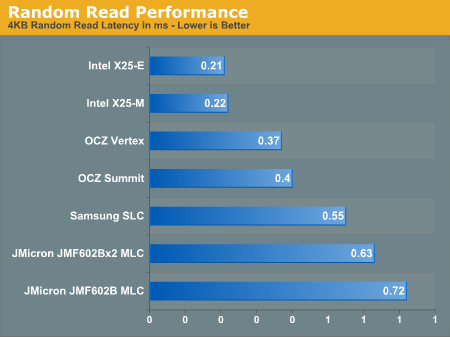The SSD Anthology: Understanding SSDs and New Drives from OCZ
by Anand Lal Shimpi on March 18, 2009 12:00 AM EST- Posted in
- Storage
SSD Aging: Read Speed is Largely Unaffected
Given the nature of the SSD performance-over-time “problem” you’d expect to only pay the performance penalty when writing files, not reading. And for once, I don’t have any weird exceptions to talk about - this is generally the case.
The table below shows sequential read performance for 2MB blocks on new vs. “used” SSDs. I even included data for a couple of the hard drives in the "Used" column; for those numbers I'm simply measuring transfer rates from the slowest parts of the platter:
| 2MB Sequential Read Speed | New | "Used" |
| Intel X25-E | 240.1 MB/s | |
| Intel X25-M | 264.1 MB/s | 230.2 MB/s |
| JMicron JMF602B MLC | 134.7 MB/s | 134.7 MB/s |
| JMicron JMF602Bx2 MLC | 164.1 MB/s | 164.1 MB/s |
| OCZ Summit | 248.6 MB/s | 208.6 MB/s |
| OCZ Vertex | 257.8 MB/s | 250.1 MB/s |
| Samsung SLC | 101.4 MB/s | |
| Seagate Momentus 5400.6 | 77.9 MB/s | - |
| Western Digital Caviar SE16 | 104.6 MB/s | 54.3 MB/s |
| Western Digital VelociRaptor | 118.0 MB/s | 79.2 MB/s |
The best SSDs still transfer data at over 2x the rate of the VelociRaptor.
Read latency is also extremely good on these worn SSDs:

I left the conventional hard drives out of the chart simply because they completely screw up the scale. The VelociRaptor has a latency of 7.2ms in this iometer test with a queue depth of 3 IOs; that's an order of magnitude slower than the slowest SSD here.
Since you only pay the overhead penalty when you go to write to a previously-written block, the performance degradation only really occurs when you’re writing - not when you’re reading.
Now your OS is always writing to your drive, and that’s why we see a performance impact even if you’re just launching applications and opening files and such, but the penalty is much less tangible when it comes to read performance.










250 Comments
View All Comments
matrixireland - Thursday, December 24, 2009 - link
hi would like to know what you pros think of the;Golden Leopard ASAX-ZIF1.8-SSD? what would you add to it?
And how would you rate it against other ssd?
Specifications:
product description
ASAX-ZIF1.8-SSD is a high-performance design solid state drive based on the high-end micro-control IC with flash memory storage medium integrated advantaged of high speed,convenient ,aseismatic,energy-saving etc.
specification
Model
Size
Interface
Material
ASAX-ZIF1.8-SSD
1.8inch 70×54×6mm
ZIF
Aluminum-magnesium alloy appearance ,drawbench and colorful oxidation surface,elegant temperament
performance
read speed:80- 96Mbytes/second write speed:50- 60Mbytes/second
support ATA-7 V3 PIO/multi word/ultra DMA MODES
Low power TFBGA,4 channel of flash controller,masked ROM and data SRAM
SAMSUNG flash keeps the data faster on reliability and endurance
Dynamic and static wear-leveling prolong NAND FLASH and SSD for longer life
8/16 bit BCH ECC data error correction ability effectively guarantee the data read security.
Design consideration
Capacity
16G/32G/64G/128G/256G
Average access time
<0.25MS
operating temperature
0-85°
power consumption
DC Input Voltage(3.3V or 5 V ± 10%)Read and write:135mA/194Ma wait:70mA
shock
1500G
Application
the Laptop, pc, server,workstation,portable media player,digital collection apparatus and any computer equipment which need consecutive read and write speed and high reliability storage.
jay401 - Wednesday, March 18, 2009 - link
yeah, he wants "more expensive than" or "too expensive for".Spoelie - Wednesday, March 18, 2009 - link
Second page as well:missing charts before and after this paragraph:
"The chart above shows how much faster these affordable MLC SSDs were than the fastest 3.5” hard drive in sequential transfers. But now look at random write performance:"
Spoelie - Wednesday, March 18, 2009 - link
chart 1 on page 2 now shows sequential read but the paragraph is changed to mention random read ;)page 21: As far as I know, this is THE one of THE only reviews
Some very surprising benchmark results for the ocz vertex, I thought the new firmware tanked sequential read speeds (to 80-90) based on the explanation beforehand, but not according to the actual graphs.
Spoelie - Wednesday, March 18, 2009 - link
third page, first table, first column: SSD and HDD entries are switchedmikaela - Tuesday, March 16, 2010 - link
yeah great info. also great resourceSpoelie - Wednesday, March 18, 2009 - link
page 19: I’d never reviewed it'd & -ed?
HolyFire - Wednesday, March 18, 2009 - link
"I'd never reviewed it" is correct. "I'd" here means "I had", it's Past Perfect tense.FishTankX - Wednesday, March 18, 2009 - link
That should have bolded "too"FishTankX - Wednesday, March 18, 2009 - link
Also, I think the velociraptor vs X-25 figures are swapped. 6 odd ms for the intel drive and 0.11ms for the velociraptor..